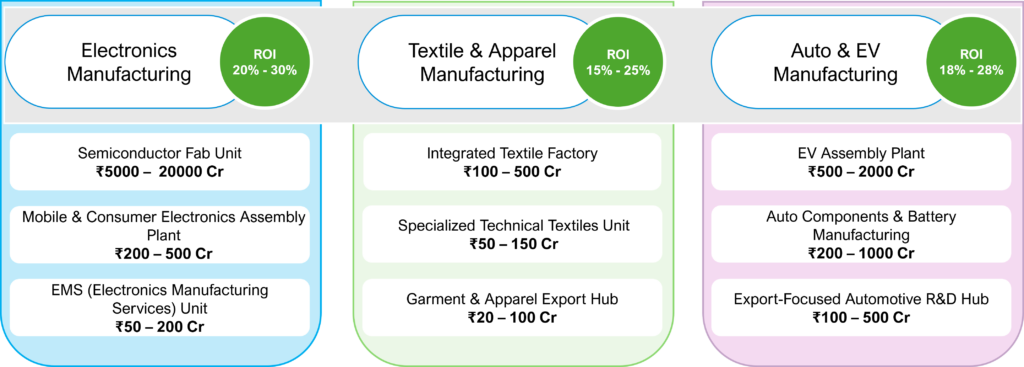Electronics, Textiles and Auto Manufacturing Opportunity Landscape

Market Overview and Growth Potential
India’s manufacturing sector is set for rapid expansion, supported by government initiatives such as Make in India, PLI schemes, and increased infrastructure investment. The Union Budget 2025-26 emphasizes:
- Expansion of domestic electronic and semiconductor manufacturing
- Growth in textile exports with incentives for value-added production
- Auto and EV manufacturing push with export-oriented policies
Key Market Indicators:
- India’s manufacturing sector projected to reach $1 trillion by 2027
- PLI schemes to boost electronic and auto manufacturing by ₹50,000 crore
- India’s textile exports to exceed $100 billion by 2030
- EV exports projected to grow at 35% CAGR over the next decade
Government Policies and Budgetary Support
Budget 2025-26 Incentives:
- ₹50,000 crore allocation for manufacturing sector growth
- PLI incentives for semiconductor, electronic manufacturing, and auto industries
- Subsidies for textile exporters and duty drawbacks for key markets
- Tax benefits for R&D and infrastructure investment in manufacturing
Key Challenges and Risks
- High capital costs for setting up large-scale manufacturing plants
- Global supply chain disruptions and raw material price volatility
- Compliance with environmental and labor regulations in exports
- Competition from established global manufacturing hubs
Implementation Roadmap
Short-Term (0-2 Years)
- Establish pilot projects and secure PLI scheme benefits
- Develop local supply chains and secure global partnerships
- Focus on high-value manufacturing exports
Medium-Term (2-5 Years)
- Scale up production facilities with advanced automation
- Expand export markets with trade agreements and logistics hubs
- Enhance R&D for competitive product innovation
Long-Term (5+ Years)
- Position India as a global hub for high-tech manufacturing
- Strengthen export competitiveness through sustainable practices
- Integrate AI-driven automation and Industry 4.0 solutions
Conclusion
India’s manufacturing and export sector presents high-growth opportunities with strong policy backing. Businesses can leverage government incentives, global trade opportunities, and advanced manufacturing technologies to establish scalable, export-driven manufacturing ventures.
Reach out to us by filling the form to get a project report / feasibility study done to start a business in this sector.
